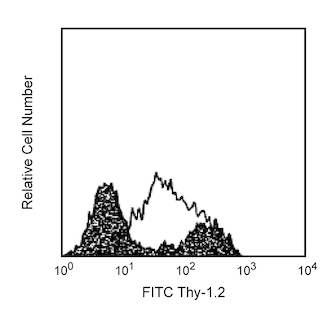Old Browser
This page has been recently translated and is available in French now.
Looks like you're visiting us from {countryName}.
Would you like to stay on the current country site or be switched to your country?


.png)

Flow cytometric analysis of CD27 on mouse splenocytes. Left Panel: Splenocytes from C57BL/6 mice were stained either with a APC Hamster IgG1, κ isotype control (shaded) or with the APC Hamster Anti-Mouse CD27 antibody (unshaded). Histograms were derived from gated events based on light scattering characteristics for lymphocytes. Middle and Right Panels: Splenocytes from C57BL/6 mice were stained with both a PE Hamster Anti-Mouse CD3e antibody (Cat.No. 553064) and either a APC Hamster IgG1, κ isotype control (middle panel) or the APC Hamster Anti-Mouse CD27 antibody (right panel). Dot plots were derived from gated events based on light scattering characteristics for lymphocytes. Flow cytometry was performed on a BD™ LSR II flow cytometry system.
.png)

BD Pharmingen™ APC Hamster Anti-Mouse CD27
.png)
Regulatory Status Legend
Any use of products other than the permitted use without the express written authorization of Becton, Dickinson and Company is strictly prohibited.
Preparation And Storage
Product Notices
- Since applications vary, each investigator should titrate the reagent to obtain optimal results.
- An isotype control should be used at the same concentration as the antibody of interest.
- Although hamster immunoglobulin isotypes have not been well defined, BD Biosciences Pharmingen has grouped Armenian and Syrian hamster IgG monoclonal antibodies according to their reactivity with a panel of mouse anti-hamster IgG mAbs. A table of the hamster IgG groups, Reactivity of Mouse Anti-Hamster Ig mAbs, may be viewed at http://www.bdbiosciences.com/documents/hamster_chart_11x17.pdf.
- Caution: Sodium azide yields highly toxic hydrazoic acid under acidic conditions. Dilute azide compounds in running water before discarding to avoid accumulation of potentially explosive deposits in plumbing.
- For fluorochrome spectra and suitable instrument settings, please refer to our Multicolor Flow Cytometry web page at www.bdbiosciences.com/colors.
- Please refer to www.bdbiosciences.com/us/s/resources for technical protocols.
Companion Products

.png?imwidth=320)

The LG.3A10 monoclonal antibody specifically binds to CD27, a lymphocyte-restricted member of the Tumor Necrosis Factor Receptor family which binds to CD70. The CD27 molecule is a 45-kDa transmembrane glycoprotein which is constitutively expressed by lymphocytes of the T lineage: virtually all thymocytes and over 90% of peripheral T cells bearing both αβ and γδ T-cell receptors. CD27 cooperates with the pre-TCR in mediating thymocyte differentiation and expansion. In addition, one to ten percent of mature peripheral B cells express CD27, and CD27's role in the differentiation of human plasma cells has been studied. Mouse NK cells, freshly isolated and IL-2-activated, also express CD27. In the bone marrow, CD27 is found on a progenitor population which provides short-term hematopoietic reconstitution. Cells of the myeloid lineage do not express CD27. Cross-linked LG.3A10 mAb has been reported to amplify the proliferative response of purified T lymphocytes to suboptimal mitogenic stimulation1 and to enhance NK-cell proliferation and IFN-γ production. In contrast, non-cross-linked LG.3A10 mAb inhibits CD3-induced pre-T cell development by interfering with the receptor-ligand interaction. This hamster mAb to a mouse leukocyte antigen has been observed to cross-react with a similar population of rat leukocytes.

Development References (6)
-
Agematsu K, Hokibara S, Nagumo H, Shinozaki K, Yamada S, Komiyama A. Plasma cell generation from B-lymphocytes via CD27/CD70 interaction. Leuk Lymphoma. 1999; 35(3-4):219-225. (Biology). View Reference
-
Gravestein LA, Blom B, Nolten LA, et al. Cloning and expression of murine CD27: comparison with 4-1BB, another lymphocyte-specific member of the nerve growth factor receptor family. Eur J Immunol. 1993; 23(4):943-950. (Biology). View Reference
-
Gravestein LA, Nieland JD, Kruisbeek AM, Borst J. Novel mAbs reveal potent co-stimulatory activity of murine CD27. Int Immunol. 1995; 7(4):551-557. (Immunogen). View Reference
-
Gravestein LA, van Ewijk W, Ossendorp F, Borst J. CD27 cooperates with the pre-T cell receptor in the regulation of murine T cell development. J Exp Med. 1996; 184(2):675-685. (Biology). View Reference
-
Takeda K, Oshima H, Hayakawa Y, et al. CD27-mediated activation of murine NK cells. J Immunol. 2000; 164(4):1741-1745. (Biology). View Reference
-
Wiesmann A, Phillips RL, Mojica M, et al. Expression of CD27 on murine hematopoietic stem and progenitor cells. Immunity. 2000; 12(2):193-199. (Biology). View Reference
Please refer to Support Documents for Quality Certificates
Global - Refer to manufacturer's instructions for use and related User Manuals and Technical data sheets before using this products as described
Comparisons, where applicable, are made against older BD Technology, manual methods or are general performance claims. Comparisons are not made against non-BD technologies, unless otherwise noted.
For Research Use Only. Not for use in diagnostic or therapeutic procedures.
Report a Site Issue
This form is intended to help us improve our website experience. For other support, please visit our Contact Us page.